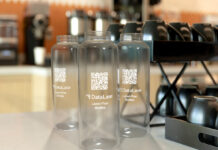Stefano Pistoni, senior manager, business development, wine & spirits and beverage, at UPM Raflatac discusses how producers can create stylish yet sustainable labels that hit their mark, based on latest research
THE global wine packaging market is estimated to be worth $5.69 billion in 2024, with expectations this will reach $7.43 billion by 2029, growing at a CAGR of 5.48% during the forecast period (2024-2029). As a result of rising interest in sustainable solutions, the wine packaging sector has seen a 20% increase in demand for eco-friendly packaging materials.
According to the latest data, new innovations catering for this demand include twist-off corks, bottle wraps, thinner eco-glass, laser-cut labels and etched glass.
Many producers are looking to reduce the environmental footprint of their wine and spirits packaging; however, consumers are still significantly influenced by the look and feel of the package, over and above its brand name and price.
This reliance can be seen in a study on the wine sector conducted by wine.net, where 82% of a sample of 2,000 consumers relied primarily on the label to choose their favourite wine.
Many other studies have also commented on the link between the perceived taste of wine and expectations, and how these are influenced by the label’s colour, shape, paper, printing technique, and overall design.
UPM Raflatac recently joined forces with other partners in the value chain, ARGEA, SenseCatch, Kurz and Krämer Druck, to discover the power of wine labels to influence the tasting and purchasing experience of consumers. The neuro-marketing research was undertaken using a scientific research method by SenseCatch focusing on white wine consumers in Germany that examined the interplay of the human senses to form an overall picture of the wine buyers’ purchasing journey. It focused on 32 white wine labels in the same shape and size as the Asio Otus Chardonnay wine produced by Argea and well-known in the German market.
The wine labels were produced by combining six types of paper supplied by UPM Raflatac with five KURZ finishings. The graphics and textual content of each label were the same but differed in terms of paper characteristics (tint, degree of opacity, thickness, degree of roughness, and tactile effect) and enhancements (colour, thickness, relief – embossing/debossing – and gloss).
The results demonstrate that the appearance of the label and its tactile sensation influence its attention-grabbing ability on the shelf and the product-tasting experience, both in terms of perceived quality and taste. When it comes to purchasing behaviour, the effectiveness of the wine label was shown to be strongly driven by its colour, tactility, contrast, and paper-finishing combination, with the findings showing the following:
• Colour: consumers are more inclined to purchase bottles with labels that have gilded and glittering finishes and have light and opaque paper.
• Tactile dimension: purchasers prefer embossed paper with a good degree of relief, and smooth embossed finishes with tactile effects are appealing.
• Contrast: consumers are drawn to contrast and prefer features such as textured paper with a matte surface and glossy embossed finish.
• Paper-finishing combination: the effectiveness of individual details is dependent on the combination of elements.
So, how can producers ensure high visual appeal, yet still deliver in terms of sustainability targets? Part of the solution lies in the choice of label. That is why UPM Raflatac has launched a collection of wine, spirits and beverage label materials – Rêverie 3 – that embraces circularity by using recycled fibres in aesthetically attractive labels.
The collection, assessed by leading Spanish designers, demonstrates that sustainability and impactful design can work together to deliver stunning results. The Rêverie 3 collection offers packaging designers a toolkit of visually appealing labels that are all made with materials from well-managed, FSC-certified forests and other controlled sources with recycled content.
Making more sustainable decisions, whilst still delivering impactful labels is straightforward, thanks to innovative materials such as those found in the Rêverie 3 product range.














